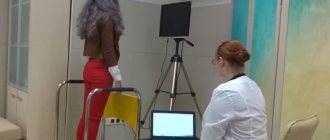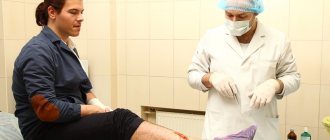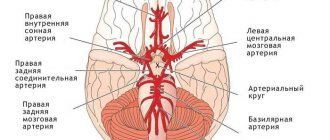Episodic ataxia, that is, temporary unsteadiness when walking and chaotic sweeping movements, is classified as a genetic neurological disease. The patient staggers when walking, may fall and not get up until the end of the attack. He is unable to pick up an object, fasten a button, or drink water on his own.
Movements lose their smoothness, become chaotic, abrupt, sweeping, arms and legs tremble.
Then the attack stops and the patient returns to relative normalcy.
You can get the altered gene from any of the parents, while the trait “presence of episodic ataxia” itself is inherited in three out of four cases, that is, according to the dominant type.
Periods of relative well-being are followed by attacks of uncoordination of movements; the child cannot control his movements for some time. Outwardly, episodic ataxia resembles manifestations of epileptic syndrome, but in essence there are a number of significant differences:
First, during episodic ataxia the patient does not lose consciousness, and the EEG does not record epileptic activity.
That is why monitoring is always necessary, that is, a series of studies of the electrical activity of the brain, since an epileptic attack as a whole can occur very differently: as “classic” convulsions, as twitching of individual muscle groups, it can look like a “freezing” of the gaze, like an attack of aggression and \or psychomotor agitation. An epileptic attack can imitate a migraine and even “pathologically deep sleep”...
There are a lot of clinical variants of epileptic paroxysms. Only EEG monitoring will make it possible to differentiate epilepsy from another disease and make the correct diagnosis in time and select treatment.
Secondly, the attack is provoked by physiological or psychological stress: heat or cold, fatigue, overexertion, emotionally significant events.
Ataxia, literally translated as “disorder,” is the inability or significant difficulty in performing conscious and purposeful actions. Until recently, smooth and precise movements acquire sharpness and sweep, and misses of the target are recorded. Hands tremble (this is called ataxic tremor), standard coordination tests are not performed: you cannot reach the tip of your nose with your finger, take the desired object without dropping the rest, clap your hands several times. The legs may also tremble, the gait becomes unsteady, with legs widely spaced (“marine”). There is a high risk of falls and, consequently, injuries. When falling, the patient cannot group himself or protect vital organs, and the very attempt to “pull himself together” and suppress involuntary movements only intensifies the tremor.
Ataxia can also affect the speech apparatus (speech disturbances are noted), then we hear monotonous, aspirated speech, unexpected pauses and a staccato effect, chanted speech.
This imbalance of voluntary motor processes lasts from several minutes to several hours, and then disappears, in some cases without a trace until a new paroxysm (attack). Sometimes a slight ataxia persists between attacks, because the tissues of the cerebellum, the center of coordination of movements, gradually atrophy.
The disease manifests itself in childhood or adolescence, episodes of ataxia occur with different frequencies: several times a day, daily, a couple of times a week, monthly. With age, this figure decreases.
Development of the disease
Every human movement is the work of different muscle groups, depending on the correct relationship of 3 elements. This:
1 - structures and connections of the cerebellum (the main organ of movement coordination);
2 - receptors that react to the current state of the joint capsule, tendons, muscles and their conductors;
3 - vestibular apparatus, which evaluates incoming impulses and body position.
If any failure occurs in these elements, disease occurs. The type of ataxia depends on what exactly was affected. Accordingly, there are types of ataxia:
sensitive ataxia - the susceptibility of deep muscle conductors is impaired;
vestibular ataxia - damage occurs in the system responsible for balance;
Cerebellar ataxia is a disruption of the functioning of this part of the brain;
frontal or cortical ataxia - dysfunction of the cortex of the frontal or temporo-occipital region.
Types of diseases transmitted by inheritance are separated into a separate group. These are: Friedreich's familial ataxia, Pierre-Marie's cerebellar ataxia, ataxia-telangiectasia (Louis-Bar syndrome). Spinocerebellar ataxia is a separate hereditary disease and today about twenty of its forms are known.
Causes and signs of ataxia
The disease can manifest itself as a result of mechanical damage to the skull or brain, hydrocephalus, cerebral palsy, congenital anomalies of brain development or infectious diseases, circulatory disorders, the presence of tumors and abscesses, and genetic predisposition.
The causes of sensitive ataxia are usually various vascular pathologies, tumors, lesions of the posterior nerves and brain stems, peripheral nodes, and the parietal lobe of the brain. In patients, the correct sensations of the surface are disturbed; for example, hard asphalt may seem like a carpet. Therefore, it is important for them to control their vision over their movements; they constantly look at their feet. When walking, bend your knees strongly, stepping loudly.
Cerebellar ataxia (the most common) occurs when the cerebellum is damaged, which can be caused by multiple sclerosis, genetics, encephalitis, tumors, infections, toxic substances, inflammatory processes, hypothyroidism, deficiency of vitamins E and group B. The symptoms of this ataxia are expressed as follows: the patient staggers in the process of walking, he places his legs wide apart, makes sweeping movements, it is difficult for him to coordinate actions both by opening and closing his eyes, speaks slowly, writes in uneven letters, and has decreased muscle tone.
The causes of vestibular ataxia usually lie in damage to this organ of balance, which occurs as a result of the appearance of brain tumors, Meniere's syndrome, encephalitis and other diseases. Typical clinical picture: dizziness, nausea, aggravated by head movements, vomiting.
Frontal ataxia in most cases is caused by abscesses, poor circulation in the brain, and the presence of malignant neoplasms. Such patients are characterized by unsteady walking, may fall over when turning, their sense of smell is impaired, changes in the psyche are observed, and the grasping reflex does not work.
Episodic ataxia type 1
The attack is expressed by myokymia in combination with ataxia. Myokymia or muscle wave is a period of contraction of a muscle or part of it, visible twitching without movement. This attack lasts a couple of minutes, first appearing in early childhood. The cause of the disease is a mutation in the genes that ensure potassium-sodium transmission: there are fewer potassium channels, their shape changes, cell membranes sense potassium deficiency, as a result, cells slowly relax after tension. The balance of excitation and inhibition of the cerebellum, motor neuron cells of the spinal cord and peripheral nerves is significantly affected.
Actually, the disease develops in middle-aged children, approximately 7 to 12 years old. Fear, physical exertion, previous somatic illnesses, strong emotions, sudden movements - all this can provoke an attack.
The child experiences stress, reacting to it with muscle tension and an attempt to act quickly. However, excessive stimulation leads to the fact that the cells often tense up and do not have time to relax. As a result, local muscle twitching (myokymia) develops and control of movements is lost (ataxia). These children are ten times more likely to develop epilepsy than usual.
Clinical picture
Ataxia is accompanied by cerebellar disorders:
- feeling dizzy (dizziness);
- seeing double;
- myokymia – isolated muscle twitching;
- nausea, vomiting occurs;
- speech and vision are impaired.
Such an attack lasts from several minutes to several hours, repeating up to 10-15 times a day. In addition to ataxic attacks, myokymia is observed during the interictal period - twitching of the muscles of the face, feet, legs, hands, and forearms.
Episodes can occur spontaneously and after movement, fear, against the background of illness, strong positive and negative emotions.
How does an episode of episodic ataxia type 1 develop?
A seven-year-old child was playing, running, enthusiastically pretending to be a super machine, and suddenly he was frightened by the crash of a vase broken in the heat of play. Suddenly his hands begin to tremble, his face twitches, the baby awkwardly tries to run to his mother and falls, severely breaking his knee. He begins to cry, bursts into tears, and answers questions from his worried relatives in a changed voice, syllable by syllable: “Mom-mama..mama.” The mother hugs the child, and he seems to break free, “swatting away” the comforters with sharp movements. Vomiting begins. Twenty minutes pass, and the movements gradually calm down, only convulsive sobs and twitching of the face indicate that there was an attack after all... And the mother thinks: Isn’t this epilepsy?
Then parents notice that sometimes, with fever, fear or tension, the face or calf muscle twitches on their own for several minutes, and the pediatrician doubtfully pronounces the frightening word “myoclonus.” The time has come for differential diagnosis.
Diagnosis and treatment of episodic ataxia type 1
For diagnosis it is necessary to carry out:
- Genetic analysis,
- Electromyography, which will detect constant tension in individual muscle fibers.
- There is usually no epi-activity on the EEG in episodic ataxia, but in many cases the disease occurs in combination with epilepsy and requires a long-term electroencephalogram of wakefulness and sleep.
Treatment is aimed at stopping and preventing the development of attacks. It includes antiepileptic and sedative therapy (acetazolamide, carbamazepine, phenotonin, valproate, phenobarbital).
The disease is incurable, but with age, attacks become easier and less frequent.
Symptoms of inherited ataxia
Friedreich's ataxia is the most common hereditary ataxia and is expressed by increasing manifestations of degeneration of the posterior and lateral trunks of the spinal systems, as well as the posterior spinocerebellar tract. Patients walk unsteadily and are carried to the sides. Later, facial and speech changes become noticeable, hearing deteriorates, and tendon reflexes decrease or disappear. If the disease is severe, the functioning of the heart is disrupted, the skeleton and legs are bent, and joint dislocations become more frequent.
Manifestations of Pierre-Marie ataxia are similar to those of cerebellar ataxia. It is usually diagnosed in people around 35 years of age and begins with gait disturbances. Over time, changes appear in speech and facial expressions, hand movements, muscle strength in the legs decreases, and there may be involuntary shudders. Even later, vision deteriorates, intelligence becomes weaker, nervous disorders and depression appear.
Ataxia telangiectasia is usually diagnosed at an early age and develops quickly. At about the age of 10 years, the child already has difficulty walking and signs of mental retardation appear. Immunity also malfunctions - children are much more likely to suffer from acute respiratory viral infections, acute respiratory infections, bronchitis and pneumonia.
Familial Friedreich's ataxia
This disease is hereditary and occurs due to damage to the spinal systems. As a result of research, it was found that many patients with this type of ataxia often have consanguineous marriages in their pedigree. The main symptom of ataxia is an unsteady and clumsy gait.
The gradual development of the disease leads to impaired hand movements, problems with facial expressions, slowed speech, and hearing loss. Further development of ataxia leads to changes in the skeleton, heart rhythm disturbances, endocrine disorders, frequent dislocations, and kyphoscoliosis.
How to Diagnose Ataxia
To correctly diagnose a patient, different methods are used. Among them: MRI and electroencephalography of the brain, electromyography, magnetic resonance angiography. To establish a diagnosis of hereditary types of ataxia, DNA diagnostics is used, which makes it possible to determine the possibility of inheritance of pathogens of this disease in the family. Laboratory diagnostics are also used to check whether there are disorders of amino acid metabolism, which is one of the indicators. Examination by medical specialists: neurologist, psychiatrist, ophthalmologist is also of great importance.
Additional tests
For a more detailed study of the disease, a consultation with a neurosurgeon will be required, as well as a number of instrumental studies.
- In particular, a lot of information about the disease can be obtained using electroencephalography. This technique evaluates the electrical activity of various parts of the brain, which tends to change in various diseases.
- No less effective techniques are also CT and MRI of the brain. They allow you to study the structure of the brain layer by layer, detect violations of the structure of its tissues, identify ulcers, tumors, and hemorrhages.
- Magnetic resonance angiography will help detect tumors in the brain and assess the integrity of the arteries in the skull.
Treatment and prognosis
If you suspect a disease, you need to contact a neurologist, and if the diagnosis is confirmed, begin active treatment. Its goal will be to eliminate the cause of the disease, for example, reducing pressure in the posterior cranial fossa, removing an abscess or tumor, eliminating hemorrhage. If the cause is eliminated, body functions are usually restored. In other cases, significant improvements in quality of life are possible.
If ataxia is diagnosed, only a doctor should prescribe medications. In addition, he can recommend a certain set of exercises that strengthens muscles and improves coordination of movements, and recommend general strengthening agents (Cerebrolysin, anticholinesterase drugs, ATP, B vitamins).
Danger of ataxia and risk groups
Since this disease is associated with impaired coordination, and also contributes to respiratory and heart failure, weakened immunity, its development can lead to disability, and in advanced cases, death. But following medical recommendations often guarantees not only a significant improvement in physical condition, but also recovery. Based on statistics, the likelihood of contracting this disease is most often in people with a history of genetic predisposition, encephalitis, epilepsy, circulatory and brain disorders.









